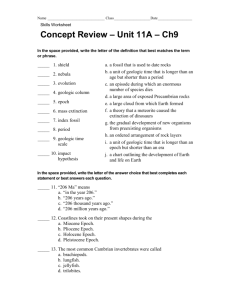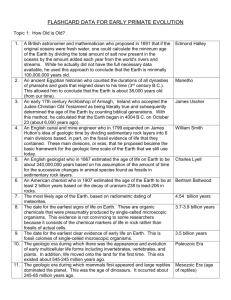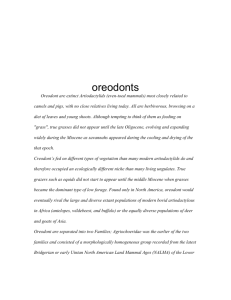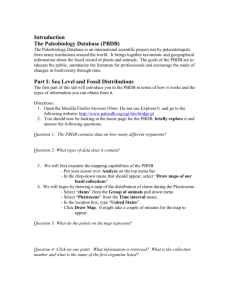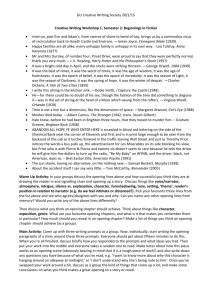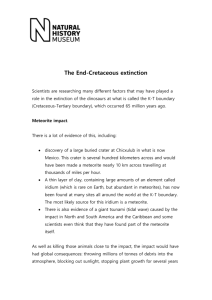detailtimescalenotes
advertisement
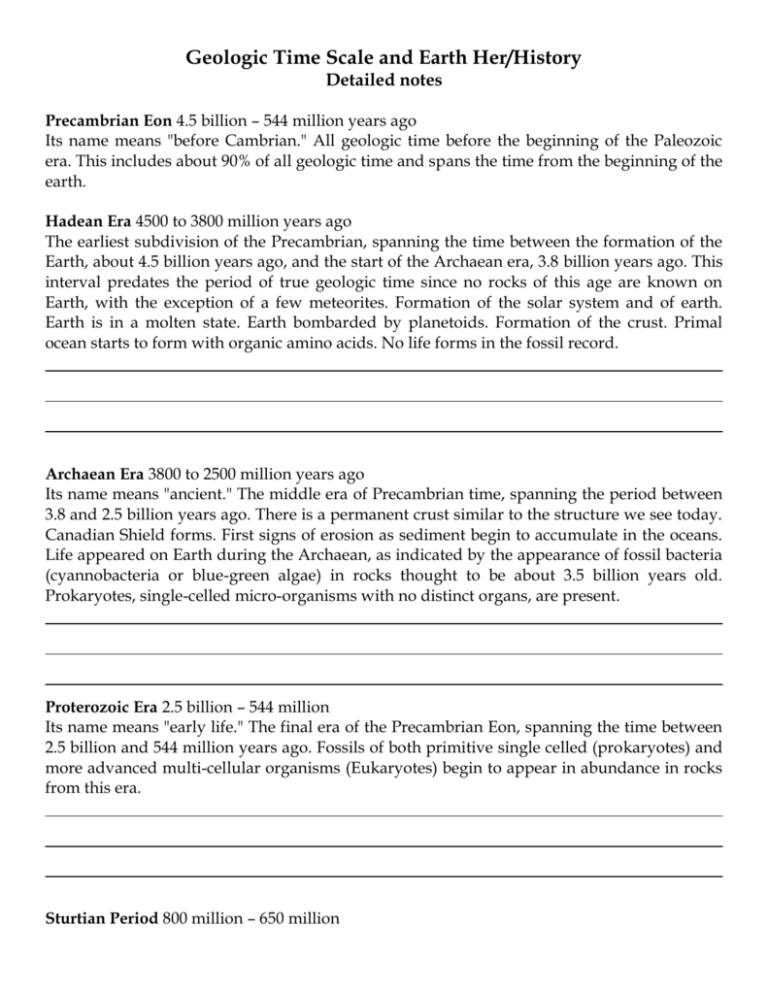
Geologic Time Scale and Earth Her/History Detailed notes Precambrian Eon 4.5 billion – 544 million years ago Its name means "before Cambrian." All geologic time before the beginning of the Paleozoic era. This includes about 90% of all geologic time and spans the time from the beginning of the earth. Hadean Era 4500 to 3800 million years ago The earliest subdivision of the Precambrian, spanning the time between the formation of the Earth, about 4.5 billion years ago, and the start of the Archaean era, 3.8 billion years ago. This interval predates the period of true geologic time since no rocks of this age are known on Earth, with the exception of a few meteorites. Formation of the solar system and of earth. Earth is in a molten state. Earth bombarded by planetoids. Formation of the crust. Primal ocean starts to form with organic amino acids. No life forms in the fossil record. Archaean Era 3800 to 2500 million years ago Its name means "ancient." The middle era of Precambrian time, spanning the period between 3.8 and 2.5 billion years ago. There is a permanent crust similar to the structure we see today. Canadian Shield forms. First signs of erosion as sediment begin to accumulate in the oceans. Life appeared on Earth during the Archaean, as indicated by the appearance of fossil bacteria (cyannobacteria or blue-green algae) in rocks thought to be about 3.5 billion years old. Prokaryotes, single-celled micro-organisms with no distinct organs, are present. Proterozoic Era 2.5 billion – 544 million Its name means "early life." The final era of the Precambrian Eon, spanning the time between 2.5 billion and 544 million years ago. Fossils of both primitive single celled (prokaryotes) and more advanced multi-cellular organisms (Eukaryotes) begin to appear in abundance in rocks from this era. Sturtian Period 800 million – 650 million Very little is known about this time. AKA: Cryogenian Period (from Greek cryos "ice" and genesis "birth") is the second geologic period of the Neoproterozoic Era, followed by the Ediacaran Period. The Cryogenian includes the Sturtian and Marinoan (formerly considered together as the Varanger) glaciations, and lasted from 800 Ma (million years ago, boundary defined chronometrically) to approximately 650 Ma. The name is derived from the glacial deposits characteristic of the period, indicating that at this time, the Earth suffered the most severe ice ages in its history, with glaciers extending to the equator, in a series of rhythmical pulses. These glaciations are represented by tillite deposits in Congo, Sahara, and Oman, in Australia and in China, and in North America, Ireland, Scotland, and Norway, and many other places around the world. It is generally considered to be divisible into at least two major worldwide glaciations. The tillite deposits occur also in places which were at low latitudes during the Cryogenian, a phenomenon which led to the hypothesis of the deeply-frozen planetary oceans called "Snowball Earth". The population of acritarchs (Most acritarchs are surely remains of single celled lifeforms) crashed during this glaciation and it is claimed that oxygen levels in the atmosphere increased after the glaciation. There are a number of enigmatic features about this glaciation, including indications of glaciation at very low latitudes and the presence of limestones -sediments that are normally warm water above and below and intermixed with glacial deposits. Paleomagnetism seems to show very high continental drift rates, leading some geologists to question whether some of the phenomena might be due to magnetic pole wandering rather than plate motion and low latitude glaciation. Basically, a very lopsided distribution of continental crust causes the Earth's daily rotation to produce angular momentum, which would cause the Earth to rotate (while its daily rotation axis stays in the same direction) until the aggregation of continents is on the equator; this causes apparent continental drift that is much faster than average rates. Vendian Period 650 million - 544 million years ago (AKA: Ediacaran) The latest period of the Proterozoic era, spanning the time between 650 and 544 million years ago. Sometimes referred to as the Ediacaran period, the Vendian is distinguished by fossils representing a characteristic collection of complex soft-bodied organisms found at several localities around the world. Mounds of blue-green algae form structures called stromatolites are considered to be the first fossils. Photosynthesis creates oxygen in the atmosphere which kills off many of the early living organisms. Examples of these early life forms are present in water near volcanic vents. Some simple worm-like fossils. First cnidarians (Greek for “stinging nettle”), which are animals armed with stinging cells called nematocysts. Precursors to first arthropods (“jointed leg”). Some sponges also present. Phanerozoic Eon 544 million years ago - present Means “Revealed Life”. Though it only represents about 10% of earth her/history it is arguably the most interesting with virtually all life found during this time. Paleozoic Era 544 million – 248 million The word Paleozoic is from Greek and means "ancient life." An era of geologic time, from the end of the Precambrian to the beginning of the Mesozoic, spanning the time between 544 and 248 million years ago. Fossil record shows first shellfish, insects, plants, fish, spiders, amphibians, and reptiles. Cambrian Period 544 million – 505 million It is named after Cambria, the Roman name for Wales, where rocks of this age were first studied. The earliest period of the Paleozoic era, spanning the time between 544 and 505 million years ago. Major formation of sedimentary rock. Continents are flooded with shallow seas. Mild climate. “North America” is tropical. Originally thought to be the first ‘explosion’ of life but has since been adjusted. Shelled (calcium carbonate) organisms in oceans. Every phylum of invertebrate is represented in fossil record. Trilobites abundant. First active predators/ hunters. Some brachiopods (“long foot”). Simple echinoderms (“spiny skin”), which are ancestors of starfish. Possibly some early crinoids or sea lilies. A few simple jawless vertebrates like lamprey. Early sponges called archaeocyathids present; their descendants may have been the first reef-builders. Mass extinctions including oldest trilobites. AKA: “Age of Marine Invertebrates” due to tremendous diversity of organisms. Ordovician Period 505 million – 440 million It is named after a Celtic tribe called the Ordovices. The second earliest period of the Paleozoic era, spanning the time between 505 and 440 million years ago. North America, Europe and Africa colliding forming first highlands. Seas over North America at their greatest extent. Rocks are mostly sedimentary. Super-continent called Gondwana in southern hemisphere shifts toward south pole and much of it was submerged under shallow seas. In the Late Ordovician massive glaciers dropped sea levels. Mature marine ecosystems develop with some deep-water life. Graptolites- whose fossils look like saw blades. Fish with notocords (early backbones) present. Jawless fish and other sea life widespread. Some plant spores have been found suggesting primitive land plants may be in existence. Mass extinction of 60% of all marine invertebrate genera and 25% of all families become extinct. Possible reasons for extinction event are the cooling of the ocean and/or oxygen depletion. Silurian Period 440 million – 417 million It is named after a Celtic tribe called the Silures. A period of the Paleozoic, spanning the time between 440 and 410 million years ago. Earth continues its mild climate as global temps stabilize. Sea levels rise to previous levels. Mountains forming in Europe. Most of the world’s salt (halite) deposits occur at this time. Earliest land plants. Extensive coral reefs present. Jawless fish spread rapidly throughout fossil record. First fish with jaws as well as the first sharks. Crinoids (sea lilies) abundant. Brachiopods widespread. Graptolites, conodonts, corals, stromatoporoids and mollusks common. Land being invaded by arthropods (‘jointed leg”) like relatives of spiders (arachnids) and centipedes. Earliest vascular plants (plants with xylem and phloem; ferns) found in southern hemisphere; Most common plants belong to genus Cooksonia; Controversial Baragwanathia (type of advanced vascular plant called a lycophyte) found in Australia. Modern algae and fungus (ascomycete fossils). Devonian Period 417 million – 360 million A period of the Paleozoic era, spanning the time between 410 and 360 million years ago. It is named after Devonshire, England, where rocks of this age were first studied. Extensive volcanism in the eastern United States and Canada. Continents are becoming drier. Europe and North America colliding near equator- orogeny continues. South Pole located in Central Africa as South America, Africa, Antarctica, India, and Australia dominate southern hemisphere. Fish are dominant life form- armored fish (ostracoderms), placoderms of huge size, lungfish, Dunklosteous. First lobe-finned fish (sarcoterygiians) First land animals develop near the end of Devonian; first amphibians. Brachiopods, echinoderms, corals flourish. Psilotophyta (giant plants) present in southern hemisphere; Archaeopteris is an example. Also evidence of first seed plants (spermatophytes), which are very modern-type plants. Oldest known vascular plants found now in northern hemisphere are only one meter tall. Brachiopods (arm- foot) are at their most diverse. Two major groups of animals colonize land at end of Devonian: tetrapods (four legged) which are the first vertebrates and closely related to lungfish and amphibians; and wingless insects and earliest true arachnids. AKA: “Age of Fishes”. Carboniferous Period 360 million – 286 million The term ‘Carboniferous’ comes from England and refers to the large coal deposits there. A period of time in the Paleozoic era that includes the Mississippian (Lower Carboniferus) and the Pennsylvanian (upper Carboniferous) periods and extended from 354 to 290 million years ago. In the United States the separation distinguishes between the mostly limestone Mississippian and coal-bearing Pennsylvanian. The earth’s climate is still warm. Great coal swamps cover much of lowlands on earth. Orogeny in eastern US (Appalchians), Texas, Colorado, Britain (Hercynian Mountains), Eastern Europe/ Siberia (Ural Mountains). Laurussia (Europe & North America) collides with Godwanaland (Africa & South America). Though two massive ice sheets cover the South Pole, there is a decrease in seasonal variation of temperatures. The milder climates caused the decrease of lycopods (tree-like plants) and giant insects and the increase of tree ferns. Amphibians reach greatest number and diversity. First reptiles appear in the late Carboniferous. This is perhaps the greatest ‘innovation’ of this period- an Amniote egg. This is the design allowed tetrapods to lay eggs away from water- a first in the fossil record in response to more arid conditions. Earliest amniote fossil was lizardlike Hylonomus. Other tetrapods include Amphibiamus (type of Temnospondyl), Anthracosaurs, followed by Diapsids (most reptiles except turtles; dinosaurs and even birds belong to this group), Synapsids (precursors to mammals, including Dimetrodon) Increase in the diversity of insects; insects are huge. First land snails. Sharks are abundant. Great forests of ferns, gymnosperms, horsetails. Sphenopsids (like today’s so-called Horse Tails or Equisetum) become more prevalent. Continents are uplifted providing more terrestrial environments but flooded areas on the continents host bryozoans (“Moss Animals”). Sea floor dominated by brachiopods, foraminifers (single-celled protests). The Kingdom “Protista” is one of the four kingdoms including animals, plants, and fungi. Freshwater clams appear. Heavily armored fish from Devonian extinct. AKA: “Age of Amphibians” Mississippian Epoch 360 million – 325 million A period of the Paleozoic era, spanning the time between 360 and 325 million years ago. It is named after the Mississippi River valley, which contains good exposures of rocks of this age. Coal- forming swamps. Pennsylvanian Epoch 325 million – 286 million A period of the Paleozoic era, spanning the time between 325 and 286 million years ago. It is named after the state of Pennsylvania where rocks of this age are widespread. Coal- forming swamps at their fullest extent. All so-called fossil fuels (coal, oil, natural gas) are formed at this time. First reptiles. Permian Period 286 million – 248 million The final period of the Paleozoic era, spanning the time between 286 and 248 million years ago. It is named after the province of Perm, Russia, where rocks of this age were first studied. Extensive glaciation of southern hemisphere. Appalachians are fully formed- about height of Himalayas. Most of the shallow seas drain from North America. Reptiles diversify. First coniferous trees; begin to out-compete earlier forests. Many modern insects appear. First Archosaurs (“ruling reptiles”). Finback reptiles (Dimetridon) are major carnivores. Mass extinction near end of Permian when 80%+ of all life goes extinct. Last trilobites extinct by 248 million years BP. AKA: Age of Reptiles Mesozoic Era 248 million – 65 million The word Mesozoic is from Greek meaning "middle life." An era of geologic time between the Paleozoic and the Cenozoic, spanning the time between 248 and 65 million years ago. Sometimes called “Age of Reptiles” but “Age of Dinosaur” is more appropriate. Triassic Period 248 million – 213 million The earliest period of the Mesozoic era, spanning the time between 248 and 213 million years ago. The name Triassic refers to the threefold division of rocks of this age in Germany. Volcanism in eastern US. Overall climate cooler. Many areas are arid (dry) to semi-arid. Pangaea (Supercontinent) is fully formed. Continents are mountainous. Appalachians broken into basins due to uplift. Fossil record shows fewer species (decreased diversity) but populations of each are great. Ammonites, clams, snails in oceans. Dinosaurs are a specific subgroup of the archosaurs, a group that also includes crocodiles, pterosaurs, and birds. Although pterosaurs are close relations, they are not true dinosaurs. Even more distantly related to dinosaurs are the marine reptiles, which include the plesiosaurs and ichthyosaurs. First dinosaurs and the first primitive mammals in fossil record at same time. The Late Triassic (Carnian) deposits of the Ischigualasto Formation contain some of the oldest known dinosaur remains. Of those sites containing the earliest dinosaurs, Ischigualasto ranks second in fame, after the Chinle Formation of North America, but ranks first in the quality, number, and importance of its dinosaur finds. It is also the only place in the world where nearly all of the Triassic is represented in an undisturbed sequence of rock deposits, and both the overlying and underlying formations have also yielded important fossils of early dinosaurs as well as of early synapsids and freshwater fish. Only about 6% of all tetrapods found there are dinosaurs. Rhyncosaurs and cynodonts are far more common, and in fact the rhyncosaur Scaphonix accounts for half of all tetrapod fossils. This suggests that dinosaurs were not an immediate success when they first appeared, especially considering that Ischigualasto is relatively rich in dinosaur remains for such an early date. Despite the rarity of these early dinosaur fossils, their importance for understanding early dinosaur evolution is tremendous. Fossils from this site include both early ornithischians, such as Pisanosaurus, and putative early saurischians, the two major lineages of dinosaurs. These fossils therefore establish not only that dinosaurs existed by this time, but that they had begun to diversify. The carnivorous archosaur Herrerasaurus is the most numerous of these dinosaur fossils, though there is some controversy over its true nature. While it has many of the features found in dinosaurs, it lacks certain features of the hip and leg bones, and so may be a close dinosaur relative, and not a true dinosaur at all. Some paleontologists point to the hipbone arrangement, arguing that this demonstrates it is an early theropod, but this hip structure is believed to have been present in dinosaur ancestors as well. A similar dinosaur from the Chinle Formation of North America, Chindesaurus, shows that these early dinosaurs existed over a large area. Another controversial early dinosaur was found in Ischigualasto in the early 1990s. Eoraptor lunensis, the "dawn raptor", is a smaller carnivore than Herrerosaurus, and also bears a frustrating mix of primitive and specialized characters. Though not known from as many specimens, nearly complete remains have been found. The small size of the fossil, and its proportionately large eye-sockets have led some paleontologists to suggest it was actually a much larger dinosaur, and that the fossils discovered so far are from juveniles. Jurassic Period 213 million – 145 million The middle period of the Mesozoic era, spanning the time between 213 and 145 million years ago. It is named after the Jura Mountains between France and Switzerland, where rocks of this age were first studied. North America and Africa separate. Ocean basins open. Appalachians eroding. Pacific and North American plates collide with subduction occurring on the western coast. Orogeny from Alaska to Mexico. Climate warmer than today. Today, the name "Jurassic" conjures up images of the phenomenally successful book and movie, "Jurassic Park". It is quite true that the dinosaurs dominated the land fauna -- although many of the dinosaurs featured in "Jurassic Park", such as Triceratops and Tyrannosaurus rex, did not appear until after the Jurassic was over. The largest dinosaurs of the time -- in fact, the largest land animals of all time -- were the gigantic sauropods, such as the famous Diplodocus, Brachiosaurus and Apatosaurus. Other herbivorous dinosaurs of the Jurassic included the plated stegosaurs. Predatory dinosaurs of the Jurassic included fearsome carnosaurs such as Allosaurus, small, fast coelurosaurs, and ceratosaurs such as Dilophosaurus. The Jurassic also saw the origination of the first birds, including the well-known Archaeopteryx, probably from coelurosaurian ancestors. But there was more to life than dinosaurs! In the seas, the fishlike ichthyosaurs were at their height, sharing the oceans with the plesiosaurs, with giant marine crocodiles, and with modern-looking sharks and rays. Also prominent in the seas were cephalopods -- relatives of the squids, nautilus, and octopi of today. Jurassic cephalopods included the ammonites, with their coiled external shells and the belemnites, close relatives of modern squid but with heavy, calcified, bullet-shaped, partially internal shells. Among the plankton in the oceans, the dinoflagellates became numerous and diverse, as did the coccolithophorids (microscopic single-celled algae with an outer covering of calcareous plates). Land plants abounded in the Jurassic, but floras were different from what we see today. Although Jurassic dinosaurs are sometimes drawn with palm trees, there were no palms, or any other flowering plants, at least as we know them today, in the Jurassic. Instead, ferns, ginkgoes, bennettitaleans or "cycadeoids", and true cycads flourished in the Jurassic. Conifers were also present, including close relatives of living redwoods, cypresses, pines, and yews. Creeping about in this foliage, no bigger than rats, were a number of early mammals. Cretaceous Period 145 million – 65 million The final period of the Mesozoic era, spanning the time between 145 and 65 million years ago. The name is derived from the Latin word for chalk ("creta") and was first applied to extensive deposits of this age that form white cliffs along the English Channel between Great Britain and France. Lands are low and extensive. Rocky Mountains form near end of period. Africa and South America Separate. No great extinction or burst of diversity separated the Cretaceous from the Jurassic Period that had preceded it. In some ways, things went on as they had. Dinosaurs both great and small moved through forests of ferns, cycads, and conifers. Ammonites, belemnites, other molluscs, and fish were hunted by great "marine reptiles," and pterosaurs and birds flapped and soared in the air above. Yet the Cretaceous saw the first appearance of many lifeforms that would go on to play key roles in the coming Cenozoic world. Marsupials, insectivores abundant and first true flowering plants appear. Perhaps the most important of these events, at least for terrestrial life, was the first appearance of the flowering plants, also called the angiosperms or Anthophyta. First appearing in the Lower Cretaceous around 125 million years ago, the flowering plants first radiated in the middle Cretaceous, about 100 million years ago. By the close of the Cretaceous, a number of forms had appeared that any modern botanist would recognize. At about the same time, many modern groups of insects were beginning to diversify, and we find the oldest known ants and butterflies. Aphids, grasshoppers, and gall wasps appear in the Cretaceous, as well as termites in the later part of this period. Another important insect to appear was the eusocial bee, which was integral to the ecology and evolution of flowering plants. The Cretaceous also saw the first radiation of the diatoms in the oceans (freshwater diatoms did not appear until the Miocene). The Cretaceous-Tertiary Extinction (Often referred to as the K-T boundary) The most famous of all mass extinctions marks the end of the Cretaceous Period, 65 million years ago. As everyone knows, this was the great extinction in which the dinosaurs died out. (Except for the birds, of course.) The other lineages of "marine reptiles", such as the ichthyosaurs, plesiosaurs, and mosasaurs, also were extinct by the end of the Cretaceous, as did the flying pterosaurs -- although some, like the ichthyosaurs, were probably extinct a little before the end of the Cretaceous. Many species of foraminiferans went extinct at the end of the Cretaceous, as did the ammonites. But many groups of organisms, such as flowering plants, gastropods and pelecypods (snails and clams), amphibians, lizards and snakes, crocodilians, and mammals "sailed through" the Cretaceous-Tertiary boundary, with few or no apparent extinctions at all. Dinosaurs extinct by end of Cretaceous. Cenozoic Era 65 million - present Its name is from Greek and means "new life” or “recent life”. An era of geologic time from the beginning of the Tertiary period (65 million years ago) to the present. Tertiary Period 65 million – 1.8 million Name for the major portion of the Cenozoic era, the most recent of the geologic eras from around 65 – 1.8 million years ago. The name Tertiary was first used about the middle of the 18th century to describe a layer of unconsolidated sediments geologically younger than other deposits then known as Primary and Secondary. Around 1830 a fourth division, the Quaternary, was added. Although these divisions of the earth's crust seemed adequate for the region to which the designations were originally applied (parts of the Alps and plains of Italy), when the same system was later extended to other parts of Europe and to America it proved to be inapplicable. It was realized that one scheme of classification could not be applied universally: The names Primary and Secondary were generally abandoned; Tertiary and Quaternary were, and still are, used, but other geologic literature substitutes other names, including the Palaeogene and Neogene. The main divisions of the Tertiary are the Paleocene, Eocene, Oligocene, Miocene, and Pliocene epochs. Sometimes the Paleocene is included in the Eocene. At the beginning of the Tertiary, the outlines of the North American continent were very similar to those of today; by the close of the period, Europe also had emerged substantially in its present form. Marine submergences in Europe were moderately extensive, but in North America they never went beyond the Atlantic, Gulf, and Pacific coasts and the lower Mississippi valley. These inundations took place chiefly in the Eocene, Oligocene, and Miocene epochs, the continents being generally emergent in the Pliocene epoch. The Tertiary formations of either unconsolidated sediments or quite soft rocks are widespread. In the Tertiary, Gondwanaland finally split completely apart, and India collided with the Eurasian plate (see plate tectonics). The previously existing mountain ranges of North America were again elevated, the Alps, Pyrenees, Carpathians, and other ranges were formed in Europe, and in Asia the Himalayas arose. Widespread volcanic activity was prevalent. At the beginning of the period the mammals replaced reptiles as the dominant animals. Striking developments in mammalian life marked each epoch. Modern types of birds, reptiles, amphibians, fishes, and invertebrates either were already numerous at the beginning of the period or appeared early in its history. Some examples are marsupials, insectivores, bears, hyenas, dogs, cats, seals, walruses, whales, dolphins, early mastodons, hoofed mammals, horses, rhinoceroses, hippopotamuses, oreodonts, rodents, rabbits, monkeys, lemurs, apes, and humans (Australopithecus). Paleocene Epoch 65 million – 55.5 million It is named after the Greek words "palaois" (old) and "ceno" (new). Earliest epoch of the Tertiary period, spanning the time between 65 and 55.5 million years ago. Climate is mild to cool. Wide, shallow continental seas mostly gone. In Western North America, the uplift of the Rocky Mts. that marked the end of the Mesozoic era continued throughout the Paleocene, and the Cretaceous inland seas gradually withdrew from the Great Plains area and central and SW California. In Montana and Wyoming the Fort Union shales and sandstones, laid down during this epoch, are noteworthy because they overlie undeformed upper Cretaceous sediments, thus recording the demise of the dinosaurs and the rise of mammals. During this epoch, the opening of the Norwegian Greenland Sea eventually resulted in a much more significant mixing of waters, creating the cold North Atlantic Deep waters. Greenland began separating from Europe as the northern mid-Atlantic Ridge formed. Except for part of N France, Europe was largely emergent (i.e., above water). On the other side of the world, Antarctica and Australia had separated; India had completed its separation with Africa, resulting in an outpouring of basalts; and India, Africa, and Australia were about to collide with Eurasia. By the end of Paleocene time, N America's last large sea retreated to the Gulf of Mexico. The Paleocene mammals were mostly small herbivores and insectivores similar to their Mesozoic ancestors. By mid-Paleocene the ungulates, or hoofed mammals of mostly five-toed forms, became abundant. Prosimian primates (tree shrews and tarsiers) also increased in number. Some of the fossil evidence from Paleocene sediments is difficult to explain; Alaska, for example, clearly had broad-leafed evergreen floras that typically grow in tropical forests. As the land has not changed significantly in latitude since the Paleocene, the evidence of these floras is a puzzle. First known primitive primates and mammalian carnivores. Some modern plants are present. Eocene Epoch 55.5 million – 33.7 million Its name is from the Greek words "eos" (dawn) and "ceno" (new). An epoch of the lower Tertiary period, spanning the time between 55.5 and 33.7 million years ago. Climate is now mild to tropical. Many lakes in western North America. Australia separates from Antarctica. India collides with Asia. The second epoch of the Tertiary period. The Eocene in North America was marked by the submergence of the Great Valley of California and a portion of the Atlantic and Gulf coastal plain extending from New Jersey to Texas and into the present Mississippi River valley as far north as S Illinois. There was also extensive sediment deposition in the Rocky Mt. region. Eocene sedimentary formations along the Atlantic-Gulf coast are chiefly sands, clays, and marls, with some limestone and lignite; in California, Oregon, and Washington they consist of shale and sandstone, with oil and coal. The Badlands of the West are partly cut into Eocene rock formations, e.g., the Wasatch, Green River, Bridger, and Uinta formations, which contain great quantities of volcanic ash and, in some districts, oil-producing shale. The Green River formation of SW Wyoming is noted for its freshwater fossil fish. The brightly colored Wasatch formation makes up the spectacular pillars of Bryce Canyon National Park. Interpretation of Eocene rock strata is based on the succession of beds in Belgian, French, and English basins, which became type areas. The Norwegian-Greenland Sea began to open during the Eocene, and a great inundation from the Mediterranean covered most of S Europe, N Africa, and SW Asia, depositing nummulitic limestone, which is prominent in the Alps and Carpathians and from which the stones of the Pyramids were quarried. Primitive horses, tiny camels, modern birds and gigantic birds present. Hardwoods and redwoods in western US. Grasslands expand. Mammals became the dominant animals, and the ancestors of the common animals of Europe and North America made their appearance, possibly as immigrants from other regions. Eocene mammals included ancestral rhinoceroses, tapirs, camels, pigs, rodents, monkeys, whales, and the ancestral horse, eohippus, as well as animals such as the titanothere, which have since become extinct. The vegetation of the Eocene was fairly modern; the climate was warm. Oligocene Epoch 33.7 million – 23.8 million It is named after the Greek words "oligos" (little, few) and "ceno" (new). An epoch of the early Tertiary period, spanning the time between 33.7 and 23.8 million years ago. Himalayas and Alps rise from the subduction of India and Asia. Red Sea forming due to separation of Africa and Arabia. Rockies are volcanic. California collides with mid-Pacific Ridge. The third epoch of the Tertiary period. More of North America was dry land during the Oligocene than in the preceding Eocene epoch. The Gulf Coast was flooded, but the Atlantic coast N of South Carolina became emergent; the principal formation of the Gulf district was the Vicksburg limestone. The Pacific coast, like the more northern Atlantic coast, was largely elevated; erosion led to the deposition of the Oligocene portion of three sediments (the Sespe conglomerate, sandstone, and shale), which contains red beds like those of the Permian period. The great erosion of the Rockies was responsible for the deposition of the fossil-rich White River clays and sands over large areas of W Nebraska and NE Colorado and parts of Wyoming and the Dakotas. Late in the Oligocene, the John Day deposits of volcanic ash, notable for their included fossils, were formed in Oregon. In S Europe, the formations are somewhat similar to those of the Eocene; a sandstone and shale formation, the Flysch, was laid down in regions adjacent to mountain systems. The Alpine mountain building episode reached peak intensity as Africa further impinged against the Eurasian plate. In the middle Oligocene a sea extended over N Europe as far east as the Urals and was connected with the greater Mediterranean through the present Rhine valley. There are extensive deposits of Oligocene lignite in Germany, indicating swamp conditions either before or during the flood, and the Alsatian potash, salt, and gypsum are Oligocene. During the Oligocene there was considerable volcanic activity in central Europe, Scotland, Ireland, and Iceland, as well as in the San Juan Mts. of Colorado and the Absaroka Mts. of Wyoming where remnants of this volcanism persist in Yellowstone National Park. The life of the Oligocene was marked in Europe and North America by the virtual disappearance of the archaic mammals of the Paleocene. Carnivorous mammals—ancestral canines (wolves) and Felines (cats)—made their appearance, along with beavers, mice, rabbits, and squirrels. A more highly developed type of horse, giant hogs, and camels were other new arrivals. The titanotheres—mammals remotely related to the horse and the rhinoceros evolved to types of great size, then died out. The brontotherium, which appeared in North America, was the largest mammal to ever live on that continent. Running and aquatic rhinoceroses developed. The earliest elephant and a primitive anthropoid ape appeared in Africa. The climate of the Oligocene was mild and temperate in North America. Large browsing mammals. True apes appear. Origin of many modern families of flowering plants. Early rhinoceros (baluchitherium (largest land animal that ever lived)) and elephant (mastodon) present in fossil record. Miocene Epoch 23.8 million – 5.3 million It is named after the Greek words "meion" (less) and "ceno" (new). A epoch of the upper Tertiary period, spanning the time between 23.8 and 5.3 million years ago. Climate is moderate. Southern hemisphere experiences another round of extensive glaciation. Rockies continue to uplift. Volcanic activity produces the Cascade Mountains. South America and Antarctica separate. Andes Mountains forming. The fourth epoch of the Tertiary period. North America was more extensively submerged in the Miocene than in the preceding Oligocene epoch and underwent considerable crustal disturbances. The Atlantic and Gulf coasts were flooded about as extensively as in the Eocene epoch. Miocene rocks are found along the Atlantic as far north as Martha's Vineyard, but the series, everywhere thin, is thickest and least interrupted from New Jersey to Maryland. On the Gulf coast it extends from Florida westward to Texas. The Atlantic series is chiefly marls, clays, and sands, with diatomaceous earth; the Florida series, chiefly limestone (Florida having risen as an island in the late Oligocene); the Gulf series, limestone and clastic sediments. On the Pacific coast, the Great Valley of California was submerged at the beginning of the Miocene. The deposition of the Vaqueros sandstone, clay, and conglomerate was followed by the formation of the oil-rich Monterey series, partly sandstone and shale but largely diatomaceous tufa. In mid-Miocene time there was extensive mountain building in this region; the Cascades and Coast Ranges were elevating, although the Rocky Mts. had by then eroded to low relief. This disturbance was accompanied by volcanic activity—the Columbia and Snake River plateaus consist of over 200,000 sq mi (520,000 sq km) of basaltic lava flows up to 10,000 ft (3,000 m) thick—and by the first known movement along the San Andreas fault zone, engendered by the collision of the North American continental plate with the Pacific Ocean plate. Late in the Miocene a new, extensive submergence resulted in the deposition of the San Pablo shale and sandstone. The sediments of the California Miocene came chiefly from the Sierra Nevada and the Klamaths, which, through erosion, were peneplained by the close of the epoch. In the western interior of North America the Columbia River basalt plateau of Idaho, Washington, Oregon, N California, and N Nevada was formed by a great outpouring of lava, which continued in the succeeding Pliocene epoch. During the Miocene most of N Europe was elevated, but marine waters covered E Spain, S France, Italy, and a depressed area extending through Hungary to a basin around Vienna. In addition to considerable orogeny, lagoons were formed at the base of the Carpathians and north of the Caucasus in the regions now occupied by the Romanian and Baku oil fields. The mammalian life of the Miocene was marked by further stages in the development of the horse, by the multiplication and final extinction of the giant hogs, and by the appearance of the mastodons, raccoons, and weasels. Cats, camels, doglike carnivores, and rhinoceroses were common, and species of a great ape (Dryopithecus) inhabited S Europe, Asia, and Africa. In the Miocene a distinct cooling of the climate resulted in the reduction of forests and an increase in grassy plains. Whales, apes, and grazing animals widespread. Forests diminish while grasslands continue to expand. Hyena, bear, seal present. Pliocene Epoch 5.3 million – 1.8 million It is named after the Greek words "pleion" (more) and "ceno" (new). Final epoch of the Tertiary period, spanning the time between 5.3 and 1.8 million years ago. Climate cooler. Uplift and mountain-building continue and many species of animals become extinct. North and South America connect as Panama uplifts. This is the fifth epoch of the Cenozoic. By the beginning of the Pliocene, the outlines of North America were virtually the same as now. Encroachments by the sea were limited to a narrow strip along the coasts of the Carolinas, Georgia, Florida, and the Gulf Coast states, and an embayment, smaller than that of the preceding Miocene epoch, in California. The Pliocene formations on the Atlantic coast are chiefly marine marls; on the Gulf they are nonmarine sediments resulting from erosion. In California they contain much volcanic ash and some are oil-bearing. The Pliocene formations of the western interior are small and scattered. In western interior North America and on the west coast, volcanic activity continued into the Pliocene from the Miocene. The close of the Pliocene was marked in North America by the Cascadian revolution, in the course of which the Sierra Nevada was elevated and tilted to the west. The Cascades, Rockies, Appalachians, and the Colorado plateau were uplifted, and there was activity in the mountains of Alaska and in the Great Basin ranges of Nevada and Utah. In Europe the Pliocene sea covered small parts of the northwest of the continent and a large area around the present Mediterranean; a number of volcanoes were active, among them Vesuvius and Etna. There was considerable mountain building, including the folding and thrusting of the Alps. The climate of the Pliocene was markedly cooler and drier than that of the Miocene and foreshadowed the glacial climates of the Pleistocene epoch. The life of the Pliocene was notable for its modern appearance; the Pliocene marked the climax, and perhaps the initial decline, of the supremacy of the mammals. Large carnivores prowl grasslands. First appearance of upright hominids (Australipithicenes) Quaternary Period 1.8 million - present It is named after the Latin word "quatern" (four at a time). The second period of the Cenozoic era, spanning the time between 1.8 million years ago and the present. It contains two epochs: the Pleistocene and the Holocene. It was named (1759) by Giovanni Arduino, an Italian scientist who thought that the biblical great flood was responsible for its deposits. During the early Quaternary, Europe and North America were covered by the glaciers of the Pleistocene epoch. Retreat of the glaciers led to isostatic rebound of the crust in the Holocene. In the Quaternary the climate and present physical features of the earth continued to develop. Significant changes in sea level within historic times are demonstrated by the submergence of the temple of Jupiter Serapis near Naples and by the rising of the shores of the Baltic. The life of the Quaternary has been marked by the rise and dominance of humans. Pleistocene Epoch 1.8 million – 8,000 It is named after the Greek words "pleistos" (most) and "ceno" (new). An epoch of the Quaternary period, spanning the time between 1.8 million years ago and the beginning of the Holocene at 8,000 years ago. Climate fluctuates between mild and cool. Four major glacial advances and retreats (AKA: Ice Age). Sierra Nevada Mountains uplift. Analyses of the magnetic polarity in deep-sea sediment cores indicated that the Pleistocene began around 1.8 million years ago—much earlier than had previously been suspected. Since the interglacial periods of the Pleistocene were of longer duration than the time elapsed since the end of the Pleistocene 11,000 years ago, it is sometimes suggested that the Holocene, or Recent, epoch, which is occurring now, may be merely another such interglacial stage and that the glaciers may return at some future time. Among the characteristic Pleistocene mammals of North America were at least four species of elephants, including the mastodon and the mammoth, true horses, of the same genus as the domestic horse though not of the same species, saber-tooth carnivores, large wolves, giant armadillos and ground sloth, bison, camels, and wild pigs. Among the arctic mammals that ranged far south in the glacial stages were the musk ox in North America and the woolly mammoth in Europe. The Pleistocene saw the beginning of the trend toward the extinction of many mammal species, which continued into historic times. The Pleistocene is noted also for the first appearance of modern humans approximately 500,000 years ago and the migration of humans to the American continents. Large numbers of mammal species (giant mammoth, mastodon, saber tooth cats) begin to disappear by the end of Pleistocene. Holocene Epoch 8,000 - present It is named after the Greek words "holos" (entire) and "ceno" (new). An epoch of the Quaternary period, spanning the time from the end of the Pleistocene (8,000 years ago) to the present. Glaciers retreat; warming; another interglacial period. Deserts spread on a large scale Recent epoch, most recent of all subdivisions of geologic time, ranging from the present back to the time (c.11,000 – 8,000 years ago) of almost complete withdrawal of the glaciers of the preceding Pleistocene epoch. During the Holocene epoch, the sculpturing of the earth's surface to its present form was completed. Withdrawal of the glacial ice resulted in the development of the present-day drainage basins of the Missouri and Ohio rivers, the development of the Great Lakes, and a global rise in sea level of up to 100 ft (30 m) as the glacial meltwater was returned to the seas. Warming climates resulted in the poleward migration of plants and animals. The most significant development during the Holocene was the rise of modern humans, who are thought to have first appeared in the late Pleistocene. All of the races of modern humans were fully developed, with eventual worldwide distribution. Human culture developed during this epoch from a primitive one to the complex industrial society of today, in which humans themselves have become a significant factor in altering the earth's surface environment. Planetary spread of modern humans Homo sapiens (AKA: “Wise Man”). Extinction of many of the large mammals. Precambrian 4.5 Bil - 544 Mil Hadean 4.5 Bil – 3.8 Bil Archean 3.8 Bil – 2.5 Bil Proterozoic 2.5 Bil – 544 Mil Sturtian 800 – 650 Mil Vendian 650 Mil – 544 Mil Phanerozoic 544 Mil - Pres Paleozoic 544 - 248 Mil Cambrian 544 - 505 Mil Ordovician 505 - 440 Mil Silurian 440 - 417 Mil Devonian 417 - 360 Mil Carboniferous 360 - 286 Mil Permian 286 - 248 Mil Mesozoic 248 - 65 Mil Triassic 248 - 213 Mil Jurassic 213 - 145 Mil Cretaceous 145 - 65 Mil Cenozoic 65 Mil - Pres Tertiary 65 - 1.8 Mil Paleocene 65 – 55.5 Mil Eocene 55.5 – 33.7 Mil Oligocene 33.7 – 23.8 Mil Miocene 23.8 – 5.3 Mil Pliocene 5.3 - 1.8 Mil Quaternary 1.8 Mil - Pres Pleistocene 1.8 Mil - 8,000 Holocene 8,000 – Pres
